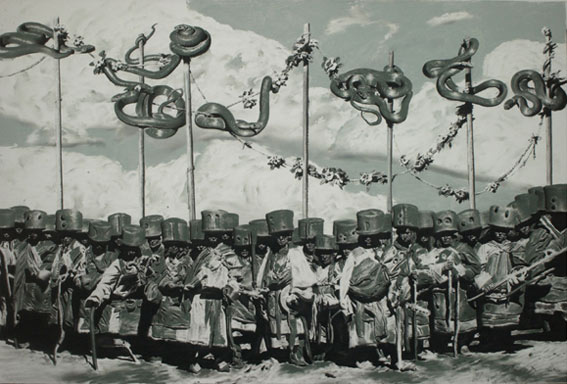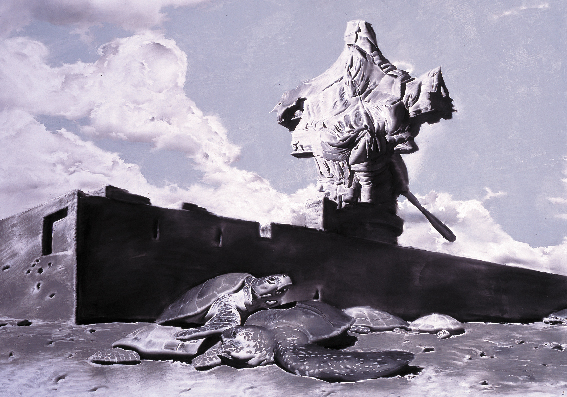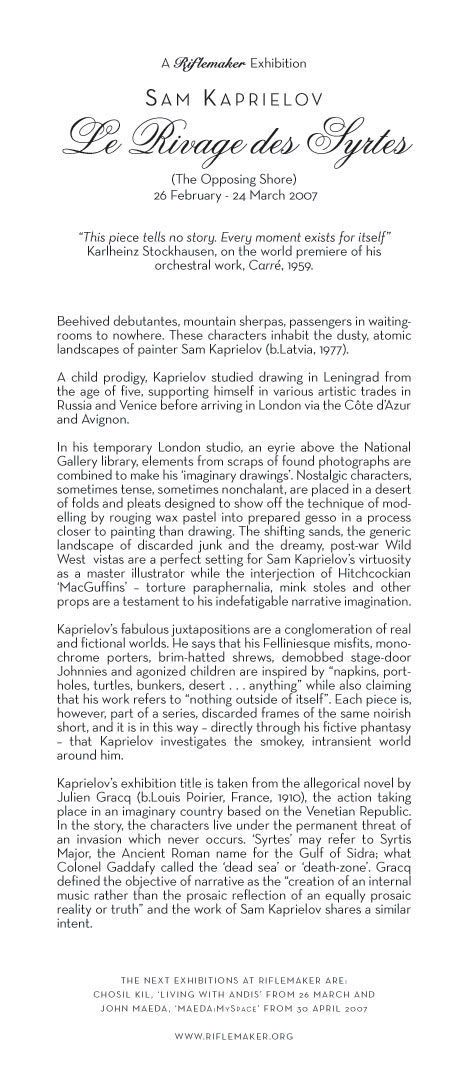Sam Kaprielov:
'Le Rivage des Syrtes (The Opposing Shore)'
'Le Rivage des Syrtes (The Opposing Shore)'
 |
 |
 |
 |
Sam Kaprielov
Le Rivage des Syrtes (The Opposing Shore) at Riflemaker 26 February - 31 March 2007
"This piece tells no story. Every moment exists for itself"
Karlheinz Stockhausen, on the world premiere of his orchestral work, 'Carre', 1959.
Beehived debutantes, mountain sherpas, passengers in waiting-rooms to nowhere. These characters inhabit the dusty, atomic landscapes of painter Sam Kaprielov (b.Latvia, 1977).
A child prodigy, Kaprielov studied drawing in Leningrad from the age of five, supporting himself in various artistic trades in Russia and Venice before arriving in London via the Cote d’Azur and Avignon.
In his temporary London studio, an eyrie above the National Gallery library, elements from scraps of found photographs are combined to make his ‘imaginary drawings’. Nostalgic characters, sometimes tense, sometimes nonchalant, are placed in a desert of folds and pleats designed to show off the technique of modelling by rouging wax pastel into prepared gesso in a process closer to painting than drawing. The shifting sands, generic landscape of discarded junk and the dreamy, post-war Wild West vistas are a perfect setting for Sam Kaprielov’s virtuosity as a master illustrator while the interjection of Hitchcockian 'maguffins’ - torture paraphernalia, mink stoles and other props are a testament to his indefatigable narrative imagination.
Kaprielov’s fabulous juxtapositions are a conglomeration of real and fictional worlds. He says that his Felliniesque misfits; monochrome porters, brim-hatted shrews, demobbed stage-door Johnnies and agonized children are inspired by “napkins, portholes, turtles, bunkers, desert . . . anything” while also claiming that his work refers to “nothing outside of itself”. Each piece is, however, part of a series, discarded frames of the same noirish short, and it is in this way - directly through his fictive phantasy - that Kaprielov investigates the smoky, intransient world around him.
Kaprielov's exhibition title is from the allegorical novel by Julien Gracq (b.Louis Poirier, 1910), the action taking place in an imaginary country based on the Venetian Republic. In the story the characters live under the permanent threat of an invasion which never occurs. 'Syrtes' may refer to Syrtis Major, the classical Roman name for the Gulf of Sidra; what Gaddafy called the 'dead sea' or 'death-zone'. Gracq defined the object of narrative as the "creation of an internal music rather than the prosaic reflection of an equally prosaic reality or truth" and the work of Sam Kaprielov shares a similar intent.
"This piece tells no story. Every moment exists for itself"
Karlheinz Stockhausen, on the world premiere of his orchestral work, 'Carre', 1959.
Beehived debutantes, mountain sherpas, passengers in waiting-rooms to nowhere. These characters inhabit the dusty, atomic landscapes of painter Sam Kaprielov (b.Latvia, 1977).
A child prodigy, Kaprielov studied drawing in Leningrad from the age of five, supporting himself in various artistic trades in Russia and Venice before arriving in London via the Cote d’Azur and Avignon.
In his temporary London studio, an eyrie above the National Gallery library, elements from scraps of found photographs are combined to make his ‘imaginary drawings’. Nostalgic characters, sometimes tense, sometimes nonchalant, are placed in a desert of folds and pleats designed to show off the technique of modelling by rouging wax pastel into prepared gesso in a process closer to painting than drawing. The shifting sands, generic landscape of discarded junk and the dreamy, post-war Wild West vistas are a perfect setting for Sam Kaprielov’s virtuosity as a master illustrator while the interjection of Hitchcockian 'maguffins’ - torture paraphernalia, mink stoles and other props are a testament to his indefatigable narrative imagination.
Kaprielov’s fabulous juxtapositions are a conglomeration of real and fictional worlds. He says that his Felliniesque misfits; monochrome porters, brim-hatted shrews, demobbed stage-door Johnnies and agonized children are inspired by “napkins, portholes, turtles, bunkers, desert . . . anything” while also claiming that his work refers to “nothing outside of itself”. Each piece is, however, part of a series, discarded frames of the same noirish short, and it is in this way - directly through his fictive phantasy - that Kaprielov investigates the smoky, intransient world around him.
Kaprielov's exhibition title is from the allegorical novel by Julien Gracq (b.Louis Poirier, 1910), the action taking place in an imaginary country based on the Venetian Republic. In the story the characters live under the permanent threat of an invasion which never occurs. 'Syrtes' may refer to Syrtis Major, the classical Roman name for the Gulf of Sidra; what Gaddafy called the 'dead sea' or 'death-zone'. Gracq defined the object of narrative as the "creation of an internal music rather than the prosaic reflection of an equally prosaic reality or truth" and the work of Sam Kaprielov shares a similar intent.